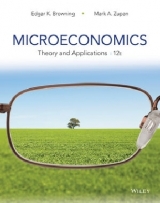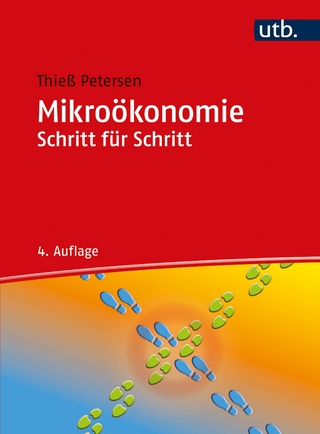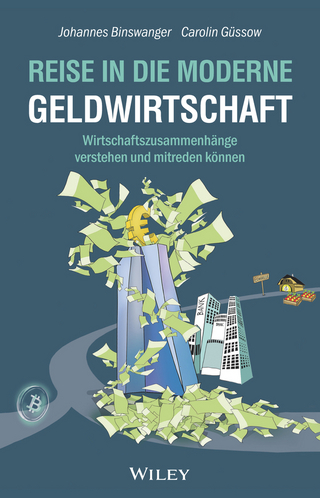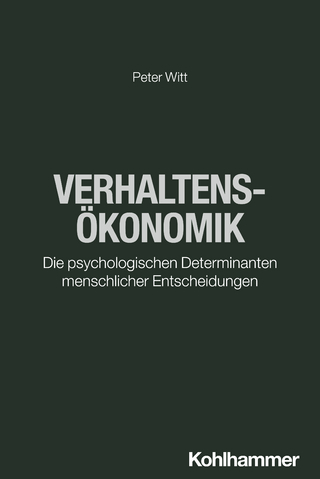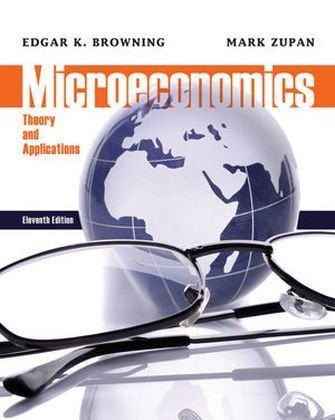
Microeconomic
John Wiley & Sons Inc (Verlag)
978-1-118-06554-9 (ISBN)
- Titel ist leider vergriffen;
keine Neuauflage - Artikel merken
Brown and Zupan's revision plan for Microeconomics: Theory & Application, 11 th Edition, includes general updates and revisions throughout including new information on behavioral economics, game theory, price theory, and problems for every chapter. The text features a new "solved" problems section in applicable chapters, and a new feature for WRK. In addition, Browning and Zupan use text and graphs, nearly without any math at all to teach microeconomic concepts. This edition is also enhanced with large clear graphs with simple exposition explaining the dynamic make learning very simple; new real-world applications which are up to date and help readers engage with the book; and international applications acknowledge that everything happens today in a global environment.
Preface v Acknowledgments x Chapter 1: An Introduction to Microeconomics 1 1.1 The Scope of Microeconomic Theory 2 1.2 The Nature and Role of Theory 2 1.3 Positive versus Normative Analysis 4 1.4 Market Analysis and Real versus Nominal Prices 5 1.5 Basic Assumptions about Market Participants 6 1.6 Opportunity Cost 6 1.7 Production Possibility Frontier 10 Chapter 2: Supply and Demand 15 2.1 Demand and Supply Curves 16 2.2 Determination of Equilibrium Price and Quantity 23 2.3 Adjustment to Changes in Demand or Supply 25 2.4 Government Intervention in Markets: Price Controls 28 2.5 Elasticities 33 2.6 The Mathematics Associated with Elasticities 42 Chapter 3: The Theory of Consumer Choice 48 3.1 Consumer Preferences 50 3.2 The Budget Constraint 59 3.3 The Consumer s Choice 63 3.4 Changes in Income and Consumption Choices 68 3.5 Are People Selfish? 74 3.6 The Utility Approach to Consumer Choice 77 Chapter 4: Individual and Market Demand 85 4.1 Price Changes and Consumption Choices 86 4.2 Income and Substitution Effects of a Price Change 91 4.3 Income and Substitution Effects: Inferior Goods 96 4.4 From Individual to Market Demand 99 4.5 Consumer Surplus 101 4.6 Price Elasticity and the Price Consumption Curve 107 4.7 Network Effects 109 4.8 The Basics of Demand Estimation 113 4.9 Deriving the Consumer s Demand Curve Mathematically 117 Chapter 5: Using Consumer Choice Theory 122 5.1 Excise Subsidies, Health Care, and Consumer Welfare 123 5.2 Subsidizing Health Insurance: ObamaCare 128 5.3 Public Schools and the Voucher Proposal 133 5.4 Paying for Garbage 137 5.5 The Consumer s Choice to Save or Borrow 141 5.6 Investor Choice 147 Chapter 6: Exchange, Efficiency, and Prices 158 6.1 Two-Person Exchange 159 6.2 Efficiency in the Distribution of Goods 165 6.3 Competitive Equilibrium and Efficient Distribution 169 6.4 Price and Nonprice Rationing and Efficiency 173 *6.5 Some of the Mathematics behind Efficiency in Exchange 176 Chapter 7: Production 180 7.1 Relating Output to Inputs 181 7.2 Production When Only One Input Is Variable: The Short Run 182 7.3 Production When All Inputs Are Variable: The Long Run 189 7.4 Returns to Scale 194 7.5 Functional Forms and Empirical Estimation of Production Functions 197 *7.6 The Mathematics behind Production Theory 201 Chapter 8: The Cost of Production 207 8.1 The Nature of Cost 208 8.2 Short-Run Cost of Production 209 8.3 Short-Run Cost Curves 213 8.4 Long-Run Cost of Production 218 8.5 Input Price Changes and Cost Curves 224 8.6 Long-Run Cost Curves 227 8.7 Learning by Doing 230 8.8 Importance of Cost Curves to Market Structure 232 8.9 Using Cost Curves: Controlling Pollution 234 8.10 Economies of Scope 237 8.11 Estimating Cost Functions 238 *8.12 The Mathematics behind Production Cost 240 Chapter 9: Profit Maximization in Perfectly Competitive Markets 245 9.1 The Assumptions of Perfect Competition 246 9.2 Profit Maximization 248 9.3 The Demand Curve for a Competitive Firm 250 9.4 Short-Run Profit Maximization 252 9.5 The Perfectly Competitive Firm s Short-Run Supply Curve 257 9.6 The Short-Run Industry Supply Curve 260 9.7 Long-Run Competitive Equilibrium 262 9.8 The Long-Run Industry Supply Curve 266 9.9 When Does the Competitive Model Apply? 274 *9.10 The Mathematics behind Perfect Competition 276 Chapter 10: Using the Competitive Model 280 10.1 The Evaluation of Gains and Losses 281 10.2 Excise Taxation 287 10.3 Airline Regulation and Deregulation 296 10.4 City Taxicab Markets 301 10.5 Consumer and Producer Surplus, and the Net Gains from Trade 304 10.6 Government Intervention in Markets: Quantity Controls 310 Chapter 11: Monopoly 316 11.1 The Monopolist s Demand and Marginal Revenue Curves 317 11.2 Profit-Maximizing Output of a Monopoly 319 11.3 Further Implications of Monopoly Analysis 325 11.4 The Measurement and Sources of Monopoly Power 329 11.5 The Efficiency Effects of Monopoly 335 11.6 Public Policy toward Monopoly 339 *11.7 The Math behind Monopoly 343 Chapter 12: Product Pricing with Monopoly Power 348 12.1 Price Discrimination 350 12.2 Three Necessary Conditions for Price Discrimination 354 12.3 Price and Output Determination with Price Discrimination 356 12.4 Intertemporal Price Discrimination and Peak-Load Pricing 360 12.5 Two-Part Tariffs 366 *12.6 The Mathematics behind Price Discrimination 371 Chapter 13: Monopolistic Competition and Oligopoly 375 13.1 Price and Output under Monopolistic Competition 376 13.2 Oligopoly and the Cournot Model 382 13.3 Other Oligopoly Models 386 13.4 Cartels and Collusion 392 Chapter 14: Game Theory and the Economics of Information 405 14.1 Game Theory 407 14.2 The Prisoner s Dilemma Game 411 14.3 Repeated Games 416 14.4 Asymmetric Information 421 14.5 Adverse Selection and Moral Hazard 425 14.6 Limited Price Information 430 14.7 Advertising 431 Chapter 15: Using Noncompetitive Market Models 437 15.1 The Size of the Deadweight Loss of Monopoly438 15.2 Do Monopolies Suppress Inventions? 442 15.3 Natural Monopoly 445 15.4 More on Game Theory: Iterated Dominance and Commitment 449 Chapter 16: Employment and Pricing of Inputs 456 16.1 The Input Demand Curve of a Competitive Firm 457 16.2 Industry and Market Demand Curves for an Input 463 16.3 The Supply of Inputs 466 16.4 Industry Determination of Price and Employment of Inputs 468 16.5 Input Price Determination in a Multi-Industry Market 471 16.6 Input Demand and Employment by an Output Market Monopoly 474 16.7 Monopsony in Input Markets 476 *16.8 The Calculus behind Input Demand by Competitive and Monopoly Firms 478 Chapter 17: Wages, Rent, Interest, and Profit 482 17.1 The Income Leisure Choice of the Worker 483 17.2 The Supply of Hours of Work 486 17.3 The General Level of Wage Rates 491 17.4 Why Wages Differ 493 17.5 Economic Rent 497 17.6 Monopoly Power in Input Markets: The Case of Unions 499 17.7 Borrowing, Lending, and the Interest Rate 503 17.8 Investment and the Marginal Productivity of Capital 504 17.9 Saving, Investment, and the Interest Rate 507 17.10 Why Interest Rates Differ 509 Chapter 18: Using Input Market Analysis 513 18.1 The Minimum Wage 514 18.2 Who Really Pays for Social Security? 521 18.3 The Hidden Cost of Social Security 524 18.4 The NCAA Cartel 528 18.5 Discrimination in Employment 534 18.6 The Benefits and Costs of Immigration 538 Chapter 19: General Equilibrium Analysis and Economic Efficiency 545 19.1 Partial and General Equilibrium Analysis Compared 546 19.2 Economic Efficiency 550 19.3 Conditions for Economic Efficiency 552 19.4 Efficiency in Production 552 19.5 The Production Possibility Frontier and Efficiency in Output 556 19.6 Competitive Markets and Economic Efficiency 562 19.7 The Causes of Economic Inefficiency 565 Chapter 20: Public Goods and Externalities 571 20.1 What Are Public Goods? 573 20.2 Efficiency in the Provision of a Public Good 575 20.3 Externalities 579 20.4 Externalities and Property Rights 585 20.5 Controlling Pollution, Revisited 589 Answers to Selected Problems 596 Glossary 604 Index 611
| Zusatzinfo | Illustrations |
|---|---|
| Verlagsort | New York |
| Sprache | englisch |
| Maße | 203 x 260 mm |
| Gewicht | 1212 g |
| Themenwelt | Wirtschaft ► Volkswirtschaftslehre ► Mikroökonomie |
| ISBN-10 | 1-118-06554-9 / 1118065549 |
| ISBN-13 | 978-1-118-06554-9 / 9781118065549 |
| Zustand | Neuware |
| Haben Sie eine Frage zum Produkt? |
aus dem Bereich
